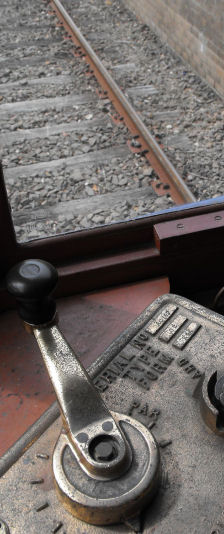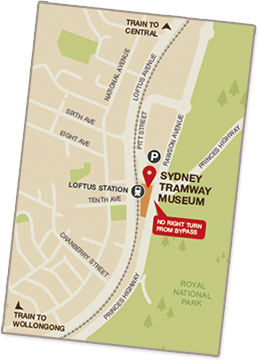Operational Tram List
The Museum’s operational fleet not only includes an extensive collection of Sydney trams from 1896 to 1997, but also trams from Brisbane, Melbourne, Ballarat, Adelaide, San Francisco, Nagasaki, Berlin, Munich and Milan, enabling comparisons between the different tramcar designs. A double-deck tram from Hobart and a Brill-built bogie car of 1902 from the Western Australian gold-mining city of Kalgoorlie still have yet to be restored.
Please note – trams cars can and do get regularly moved between the display hall and the running shed. Unfortunately members of the public are not able to inspect trams in the running shed due to safety issues.
Sydney
Victorian Veterans
The first examples of electric Sydney trams were of single truck saloon cars imported from America. It was this design that would influence locally built cars to be made likewise. Eventually, single truck and bogie truck examples of “California Combination” type trams would be introduced. As the popularity of the trams grew, capacity on these cars would become limited, and other design options would be considered. Most of the Victorian era cars however, would go on to have a second life as works cars to maintain the system. It was this example of repurposing that allowed many trams of this era to survive into preservation.
C 290 Built in 1896 by Bignall & Morrison. Acquired in 1955. Restored to original passenger condition from 1996-97. Display hall; operational for special events. Oldest operational electric tramcar in Australia.

C 29 Built in 1898 by Hudson Bros. Acquired in 1961. On loan to the Old Spaghetti Factory from 1972 to 1989. Restored to static display in 1995. Made operational in 2001. Operational in occasional service.
F 393 Built in 1902 by Clyde Engineering. Acquired in 1953. Display hall; operational for special events. Only F class car remaining, owing to its use as a driver training tram.
Cross-bench Classics
The Edwardian era saw a progressive return to the cross-bench design of trams that had seen success with the Steam Tram trailers. The layout allowed for high passenger capacity and fast unloading/loading times, which proved reliable during special events or the peak hour rush. Colloquially, the cross-bench design came to be known as “toastracks”, due to their aesthetic similarities with the kitchen item. The toastracks came to be the dominant form of tramcar design in Sydney, lasting until the closure of the Bondi and Bronte lines in 1960.
J 675 Built in 1904 by Meadowbank Manufacturing Company. Acquired in 1996. Restoration completed in 2009 by Bendigo Tramways. Operational in occasional service. (2016: Currently out of Service.)
N 728 Built in 1906 by Meadowbank Manufacturing Company. Acquired in 1953. Display hall; operational for special events.
O 805 Built in 1909 by Meadowbank Manufacturing Company. On loan from the Powerhouse Museum, acquired by PHM 1961. Display hall; operational for special events. (PHM asset record).
O 1111 Built in 1912 by Meadowbank Manufacturing Company. Acquired in 1958. Operational in regular service.
Twenties Toastracks
Prosperity in the twenties brought a new sophistication amongst the population calling for some improvements in styling and passenger comfort, though demand for high carrying capacity remained a priority. The result was the P class car; a design that provided better visibility and weather protection for passengers plus some advances in technical features as well. Other trams came to be modified to this design too, whether as a result of accidents, or just to increase general capacity.
P 1497 Built in 1922 by the NSW Department of Transport. Acquired in 1959. Operational in regular service.
L/P 154 Built in 1900 by Clyde Engineering as an F class car. Converted in 1910 to an ‘L’ type tram, and again in 1926 as an ‘L/P’ type. Acquired in 1950. Currently representing trams from the Newcastle system. Operational in occasional service. Known as the oldest preserved tram in the Southern Hemisphere.
Corridor cars
Increasing use of motor cars made it evident that public transport would need to become more competitive. Comfortable seating and ease of entry would be more important on some routes than seating capacity. Certain routes also needed improved braking. The answer was seen in the new R class cars which boasted soft leather seats and a drop-centre section. A further modification to this design – known as the R1 – saw the removal of this drop centre; allowing for more seating capacity. Both the R’s and the R1’s were first introduced in the early-mid 1930’s, with a further 100 R1’s introduced in the early 1950’s. It was these types of cars which saw out the closure of the tramway network in 1961.
R 1740 Built in 1933 by Clyde Engineering. Acquired in 1959. Operational in regular service.
R1 1979 Built in 1936 by Clyde Engineering. Acquired in 1972. Operational in regular service.
R1 2001 Built in 1951 by Commonwealth Engineering. Acquired in 2001. Restored by Bendigo Tramways for a proposed tourist tram line in Canberra. Operational in regular service.
Modern Light Rail Vehicles
In 1997, trams returned to Sydney, with the opening of the Pyrmont Light Rail line from Central Station to Wentworth Park (later extended to Lilyfield, then Dulwich Hill). The new line brought with it, a brand new form of tram that heralded a game changing step forward in tram design and technology in Australia. Known as Variotrams, they were the first ‘low floor’ trams in Australia, with five articulated sections, and a total length of 28.9 metres. Seven were built, and operated successfully for 17 years before being retired.
2107 Built in 1997 by ADtranz. Withdrawn in 2015 and placed in storage for three years. Acquired by Transport Heritage NSW for the State Moveable Heritage Collection in 2018. Placed on permanent loan to STM. Arrived at Loftus in October 2018 and slowly being returned to service. Operational but not yet certified for traffic.
Brisbane
‘Dreadnought’ 180 Built in 1924 by T Gardiner and Son. Acquired in 1958. Operational in regular service, mainly during the Summer months.
‘Dropcentre’ 295 Built in 1935 by Brisbane City Council. Acquired in 1968. Operational in regular service.
‘Phoenix’ 548 Built in 1963 by Brisbane City Council after a fire at Paddington tram depot destroyed 65 trams. One of 8 new trams that were built using salvaged and spare parts. Acquired in 1969. Operational in regular service.
Ballarat
‘Single-Truck’ 12 Built in 1908 by Meadowbank Manufacturing Company. Acquired in 1974. Display hall; operational for special events. Remains in “as is” condition.
‘Dropcentre’ 37 Built in 1916 by Duncan and Fraser. Acquired in 1971. Underwent 12 year refurbishment that was completed in 2016. Operational in regular service.
Melbourne
Note: The Melbourne Z2 link goes to an external web site – www.vicsig.net, a site with an extensive database of Victorian Railway rolling stock and infrastructure.
W2 249 Built in 1924 by James Moore & Sons for the Melbourne & Metropolitan Tramways Board. Acquired in 1996. Restored for a proposed tourist tram line in Canberra in 2001. Operational in regular service.
Y1 611 Built in 1930 as one of four one-man trams. Acquired in 2005. Restored by Bendigo Tramways in 2014. Arrived at Loftus in early 2015. Operational in regular service.
Z2 111 Built in 1979 by Comeng. Acquired in 2003. Operational in occasional service, mainly during the Winter months.
Adelaide
H 358 Built in 1929 by A. Pengelley & Sons. Acquired in 2006. (September 2019 – Out of service, waiting parts)
Overseas
San Francisco PCC “Torpedo” 1014 Built in 1948 by St. Louis Car Company. Bicentenary gift from Sydney’s sister city San Francisco in 1987. On permanent loan from Muni. Last remaining “Torpedo” PCC in original condition. Operational in occasional service.
Nagasaki 1054 Built in 1952 by Nigata Iron Works. Operated on Sendai and Nagasaki tramway systems. Acquired in 1992. Operational in occasional service.
Berlin 5133 Built in 1969 by the East German Railways. Acquired in 1996. Operational in occasional service.
Works Cars
Rail Grinder No.3 (ex-No.2) Built in 1927 by the S.& E. Co. in Bath, England. Sent to Newcastle in 1935. Returned to Sydney in 1950 upon closure of the Newcastle system. Sold to Melbourne in 1958 and renumbered No.3. Acquired by the museum in 1971. Loaned to MOTAT in Auckland, New Zealand for six years, where it was fully restored for works purposes. Returned to Loftus in late 2017. Display Hall; operational for special events. Remains in its Melbourne form.
11(W) (ex-139s) Sydney and Melbourne Scrubber Car. Built by Meadowbank Manufacturing Company in 1908 as K class passenger tram 797. Converted to scrubber car in 1953. Sold to Melbourne in 1959 when it became surplus to the shrinking Sydney tramways. Continued use as a Melbourne works vehicle until withdrawn from service in 2002. Donated to STM in 2003. Arrived on site in 2015. Overhauled and brought into museum service in 2019.
24s Sydney Freight tram. Built in 1903 to transport supplies between Randwick workshops and the multiple service depots. Withdrawn in 1949. Acquired in 1955. Restored to static display in 1997. Returned to operating condition in 2017. (November 2019 – Out of service, awaiting armature exchange)
42s Sydney Ballast motor. Built in 1907 by the NSW Government Tramways. Used by the NSW Government Railways as L707 Overhead Line car from 1926 to 1980. Acquired in 1981 and relaunched in 2009. In use as a Works Car.
99u Sydney Overhead Line Car. Built by Meadowbank Manufacturing Company in 1913. Acquired in 1958. In use as a Works Car.
134s Sydney Scrubber Car. Built by Ritchie Bros. in 1899 as D class passenger car 102. Converted to a scrubber car in 1930. Scrubber cars use Carborundum blocks to ‘scrub’ the railhead clear of debris. Acquired in 1961. Used in 1978/9 to clean the Eastern Suburbs Railway tracks. Used in 1983 for a similar purpose along the Cronulla line. Used in 1997 to ‘scrub’ the tracks around Haymarket for the new Light Rail line. Operational when required.
141s Sydney Breakdown Car. Built by Meadowbank Manufacturing Company in 1911 as O 1030. Converted to a Breakdown car in 1955. Acquired in 1962. Operational in occasional service.
Buses & Trolley Buses
Leyland Tiger Single-Deck Half-Cab No.(1)275 Built in 1937 by Waddingtons. Sold for private ownership in 1952. Acquired by the museum in 1970. The last remaining pre-war Leyland half-cab in the world.
AEC Regent 3 Double-Deck Half-Cab No.2619 Built in 1952 by Clyde. One of the last traditional double-decker motor buses in Sydney upon withdrawal. Acquired by the museum in 1976. Restored in 2016. Operational for special events.
AEC 3-Axle Double-Deck Trolleybus No.19 Built in 1937 by Ritchie Bros Pty Ltd. Acquired by the Museum in 1978. Re-built and partly fitted out, by apprentices of the then State Rail in Chullora from 1982-1988. Sydney’s last remaining double-deck trolley-bus.
The Museum’s Souvenir Guide contains more information on these trams and on other trams in the Museum’s collection.
This page thanks to Liam Brundle.





